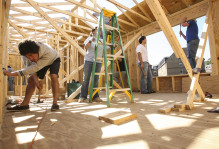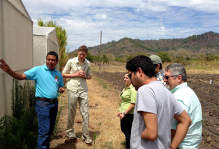Researching, Planning, and Hoping
We’re mostly present and accounted for. Two SOMOS team members had late flights (Joanna Weeks, 2nd year with the project; and Rebecca Silverstein, 1st year) and should arrive at the hotel soon. (It’s 12:30 and two of our seasoned crew are meeting them at the airport.) Following reunions fit for many months apart, the current assemblage had dinner at a local cafe and then set about final preparations for tomorrow’s meeting and community celebration.
Fourth-year medical student Morgan McCorklin (W&M ’06; I learned her newly married name tonight but haven’t yet internalized it) joins us this year as part of our medical staff, and it is a special treat for me. Morgan was among a very small group of students who asked me some years ago to organize a seminar to help them prepare for an NGO-sponsored medical mission trip (to Costa Rica). Her vision of what “service learning” and academically-based community engagement could be inspired my involvement in the projects currently known as SOMOS and MANOS, and it is a treat to watch her drink in what has evolved since her own undergraduate efforts.
This reminds me to mention an alumnus who is an essential moving force of the work we do in the Dominican Republic. Mark Ryan, M.D. (William and Mary ’96) was the medical provider for the founding student group known as WAMMMC (William and Mary Medical Mission Corps), which we know now as SOMOS. He has served as medical director since the inception of the project. His tireless efforts as physician, mentor, and collaborator make possible our research and community engagement to improve health and health care — and deliver annual medical service to hundreds of local residents who otherwise would have little chance of receiving medical care.
We will struggle this year as we come to grips with the thorny relationship between science and praxis. We have good social scientific data to help us to understand aspects of social, structural, cultural, and organizational features of the community. The research makes clear elements of local social realities that provide both opportunities and obstacles to collective efforts to improve health. We have an empirically grounded model of collective capacity building that can guide us in our use of the data and our efforts to engage local residents. It is likely that, in the end, the research makes us potentially effective facilitators of community (collective) effort. Used inappropriately, the research can encourage us to strategies that foster dependence and unrealistic hopes. We will try to use the research evidence in ways that promote local initiative informed by understandings about social organization that cannot be gleaned easily through the everyday experiences of living.
And so we are poised at this moment with good, careful, and systematic research, having labored through careful and thoughtful planning, and still dependent on the very human element of hope — hope that we can find ways to communicate sensitively and genuinely that encourage small individual efforts that combine to produce larger collective results. We’ll see what tomorrow brings.




No comments.
Comments are currently closed. Comments are closed on all posts older than one year, and for those in our archive.